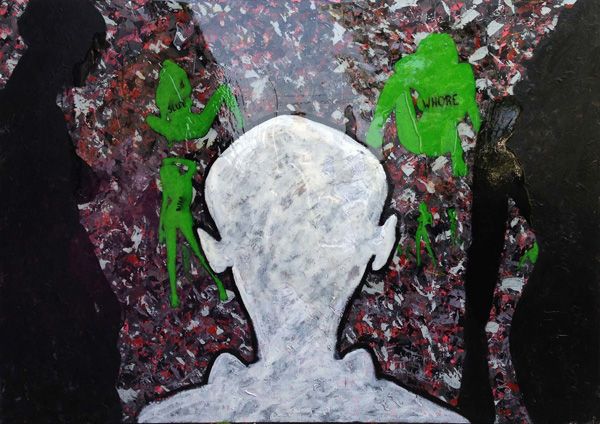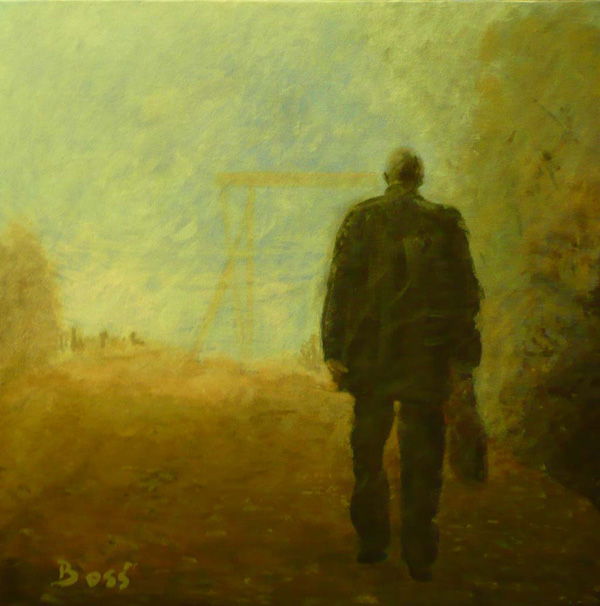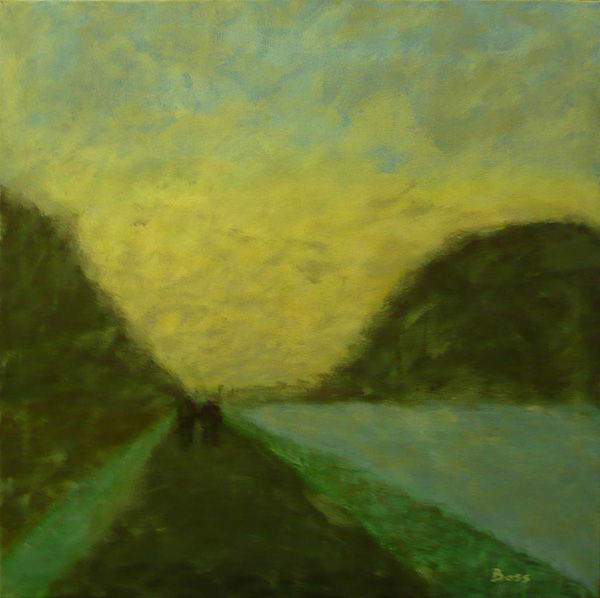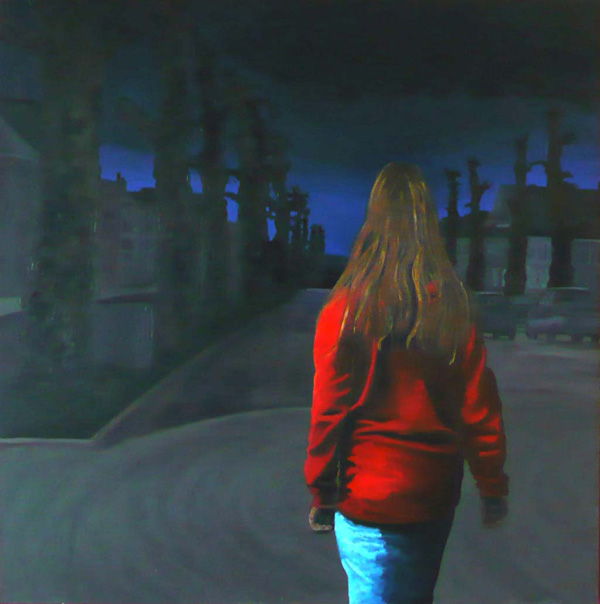Roger Raveel appearing in a perverted dream of Christopher Tracey Emin 2013 Acrylic on hardboard 150 x 105 cm

Ravevich (ode to Raveel and Malevich) 2013 Acrylic on Canvas 60 x 80 cm
.jpg)
The Wanderer 2013 Acrylic on canvas 50x50cm
 When watching over the shoulder of the protagonist of this painting, we can see a village or small town in the distance. To reach this, the man probably has to take a bridge. The man still has a long way to go. Is this town the final destination of the man? The title suggests not. We can’t find out much of the man who is turned with his back to us.
In some way the man doesn’t belong in this picture. His clothes and briefcase don’t suggest that he is a vagabond. On the other hand you don’t suspect an employee with briefcase at foot in this kind of desolate road, far away from civilization. You expect him on a busy train, queuing in a line of cars or walking on a hectic sidewalk of a city, targeted on his way to his office.
The mysterious atmosphere is amplified by the hazy brush strokes and the chiaroscuro. The canvas consists of pronounced dark and light parts. The border between dark and light is formed between the diagonal line from the right upper corner to the left bottom corner. Because of htis, the man is placed in the darker part, the destination in the lighter part. Because the man is on the foreground -and as a result bigger- he first draws the attention, but shortly after that, the eye is lead to the lighter horizon.
The title of the painting could be a reference to the painting with the same name of Caspar David Friedrich. On this painting you can also see a sharp dressed man, seen from the back, staring over a see of mist. Here, also a strong light-dark contrast is present.
Or maybe it is a contemporary adaptation of an Old English poem about a wanderer who finally sees the light after long nostalgic musing?
Of maybe it is a reference to the U2 song with the same name, which starts like this:
I went out walking
Through streets paved with gold
Lifted some stones
Saw the skin and bones
Of a city without a soul
I went out walking
Under an atomic sky
…
It would be a feat if Boss had all 3 references in mind when making this painting.
When watching over the shoulder of the protagonist of this painting, we can see a village or small town in the distance. To reach this, the man probably has to take a bridge. The man still has a long way to go. Is this town the final destination of the man? The title suggests not. We can’t find out much of the man who is turned with his back to us.
In some way the man doesn’t belong in this picture. His clothes and briefcase don’t suggest that he is a vagabond. On the other hand you don’t suspect an employee with briefcase at foot in this kind of desolate road, far away from civilization. You expect him on a busy train, queuing in a line of cars or walking on a hectic sidewalk of a city, targeted on his way to his office.
The mysterious atmosphere is amplified by the hazy brush strokes and the chiaroscuro. The canvas consists of pronounced dark and light parts. The border between dark and light is formed between the diagonal line from the right upper corner to the left bottom corner. Because of htis, the man is placed in the darker part, the destination in the lighter part. Because the man is on the foreground -and as a result bigger- he first draws the attention, but shortly after that, the eye is lead to the lighter horizon.
The title of the painting could be a reference to the painting with the same name of Caspar David Friedrich. On this painting you can also see a sharp dressed man, seen from the back, staring over a see of mist. Here, also a strong light-dark contrast is present.
Or maybe it is a contemporary adaptation of an Old English poem about a wanderer who finally sees the light after long nostalgic musing?
Of maybe it is a reference to the U2 song with the same name, which starts like this:
I went out walking
Through streets paved with gold
Lifted some stones
Saw the skin and bones
Of a city without a soul
I went out walking
Under an atomic sky
…
It would be a feat if Boss had all 3 references in mind when making this painting.
Couple 2013 Acrylic on canvas 50x50cm
 Whoever catches a first glimpse of this odd painting, is confused. The brain of the spectator needs some time to transform the abstraction of the first flash into an image representing a path neer a canal. After a moment, one might notice the couple on the path, the title of the painting refers to. In the distances an anonymous little village looms in the haze that is covering the scene from the prying eyes of the viewer.
Three dark parts dominate the canvas: the path and two areas of hillsides covered with trees. The positioning of the dark hillsides against the radiant horizon light and the alternation of dark and light strips, create a gaudy image. The comosition and the spear-shaped ornaments are positioned in a way it leads the eye automatically to the horizon and the couple.
It seems like the artist is playing a game with the spectator (without this last one noticing it): from one hand, the cleverly chosen composition forces the eye to watch where the artist wants it to watch. On the other hand, the haze and vagueness of the contours make it hard to peek.
Whoever catches a first glimpse of this odd painting, is confused. The brain of the spectator needs some time to transform the abstraction of the first flash into an image representing a path neer a canal. After a moment, one might notice the couple on the path, the title of the painting refers to. In the distances an anonymous little village looms in the haze that is covering the scene from the prying eyes of the viewer.
Three dark parts dominate the canvas: the path and two areas of hillsides covered with trees. The positioning of the dark hillsides against the radiant horizon light and the alternation of dark and light strips, create a gaudy image. The comosition and the spear-shaped ornaments are positioned in a way it leads the eye automatically to the horizon and the couple.
It seems like the artist is playing a game with the spectator (without this last one noticing it): from one hand, the cleverly chosen composition forces the eye to watch where the artist wants it to watch. On the other hand, the haze and vagueness of the contours make it hard to peek.
Ravollock (ode to Raveel and Pollock) 2013 Acrylic and laque on hardboard 42x81cm
.jpg)
This work is a tribute to Roger Raveel and Jackson Pollock. Following the decease of Roger Raveel in 2013, Boss made a series of works as a tribute to this grand master. While doing this, the painter grabbed the opportunity to honour other top artists. The result is an action painting in which Raveel brings some peace. The contrast between the nervous dripping tecnique of Pollock used in the background and the calmness in the emptiness of the Raveel figure in the foreground, give this painting a unique atmosphere. The spirit of Raveel can be found in the works of Boss.
Ravothko (ode to Raveel and Rothko) 2014 Acrylic on hardboard 110x150cm
.jpg) The decease of the Belgian artist Roger Raveel in 2013, inspired Boss for the creation of a series of works in honor of Raveel and other masters from the history of art. In these series, the same elements are used: a line figure, representing the contours of Roger Raveel and painted in his style, is depicted on a canvas, which is for the remainder painted in the style of the other artist.
In the first work of this set, Raveel is linked to Mark Rothko. The Raveel figure is drawn monumentally in front of a color field painting constructed with red and black.
The combination of the styles ot the two artists creates a new unique work: 1 + 1 = 3 in this case.
The decease of the Belgian artist Roger Raveel in 2013, inspired Boss for the creation of a series of works in honor of Raveel and other masters from the history of art. In these series, the same elements are used: a line figure, representing the contours of Roger Raveel and painted in his style, is depicted on a canvas, which is for the remainder painted in the style of the other artist.
In the first work of this set, Raveel is linked to Mark Rothko. The Raveel figure is drawn monumentally in front of a color field painting constructed with red and black.
The combination of the styles ot the two artists creates a new unique work: 1 + 1 = 3 in this case.
Young Girl From the Back 2013 Acrylic on hardboard 115x115cm
 In the foreground you can see a young girl with long blonde hair walking inside the canvas. This night scene occurs on a deserted lane with plane trees. A light source shines on the hair of th girl and makes her sweater glare in a bright orange. A bit further, some cars are hardly visible. The facades of the houses are also only slightly suggested.
The pruissian blue sky spreads a cool light on the rest of the environment and transforms the dark trees into amorphous pilars. This creates a similar mysterious atmosphere that you can find in the works of Paul Delvaux. But differently from what you can find in the works of Delvaux, the surreality doesn’t get the empahsis (no strange combinations of antique and contemporary elements, nor (half)naked female figures). The focus is on the solitude and isolation, on the threatening danger and the vulnerability of the girl, alone on a nightly lane. It is just like she is heading into a dark forest and danger is lying behind every tree.
In the foreground you can see a young girl with long blonde hair walking inside the canvas. This night scene occurs on a deserted lane with plane trees. A light source shines on the hair of th girl and makes her sweater glare in a bright orange. A bit further, some cars are hardly visible. The facades of the houses are also only slightly suggested.
The pruissian blue sky spreads a cool light on the rest of the environment and transforms the dark trees into amorphous pilars. This creates a similar mysterious atmosphere that you can find in the works of Paul Delvaux. But differently from what you can find in the works of Delvaux, the surreality doesn’t get the empahsis (no strange combinations of antique and contemporary elements, nor (half)naked female figures). The focus is on the solitude and isolation, on the threatening danger and the vulnerability of the girl, alone on a nightly lane. It is just like she is heading into a dark forest and danger is lying behind every tree.